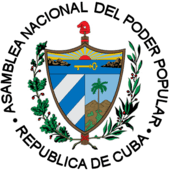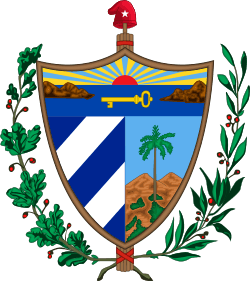National Assembly of People's Power
| National Assembly of People's Power Asamblea Nacional del Poder Popular | |
|---|---|
| VII legislature | |
 | |
| Type | |
| Type | |
| History | |
| Founded | 1976 |
| Leadership | |
| Structure | |
| Seats | 605 |
 | |
Political groups | Communist Party of Cuba |
| Elections | |
| Run-off Voting | |
Last election | 11 March 2018 |
Next election | 2023 |
| Meeting place | |
| Palacio de las Convenciones | |
| Website | |
| Parlamento Cubano | |
 |
|---|
| This article is part of a series on the politics and government of Cuba |
|
|
Executive |
|
Judiciary
|
|
The National Assembly of People's Power (Spanish: Asamblea Nacional del Poder Popular) is the legislative parliament of the Republic of Cuba and the supreme body of State power. Its members (currently numbering 605) are elected from multi-member electoral districts for a term of five years. The Assembly's current President is Esteban Lazo Hernández. The assembly meets twice a year. Between sessions it is represented by the 31 members Council of State.[1] The most recent elections were held on 11 March 2018.
Overview
The Assembly is a unicameral (one-chamber) parliament and the only body in Cuba that is vested with both constituent and legislative authority (although the government may pass decrees that have the force of law). It holds two regular sessions a year, which are public unless the Assembly itself votes to hold them behind closed doors for reasons of state. It has permanent commissions to look after issues of legislative interest at times when the Assembly is not in session.
The National Assembly has the power to amend the Constitution; to pass, amend, and repeal laws; to debate and approve national plans for economic development, the State budget, credit and financial programs; and to set guidelines for domestic and foreign policies. It hears the reports from national government and administration agencies and can also grant amnesties. Among its permanent or temporary commissions are those in charge of issues concerning the economy, the sugar industry, food production, industries, transportation and communications, constructions, foreign affairs, public health, defense, and interior order. The National Assembly also has permanent departments that oversee the work of the Commissions, Local Assemblies, Judicial Affairs, and Administration.
History
The Assembly originated from the nationwide elections held in 1976 following the ratification of the 1976 Constitution. Elected officials, according to the procedures established by law, met for the first time on 2 December 1976, thus formally setting up the Cuban Parliament. The Constitution, approved in a constitutional referendum on 14 February 1976, empowered the National Assembly as the supreme body of State power.
Elections
- See main article: Elections in Cuba
The assembly deputies are nationally elected every five years. Half of the candidates are nominated at public meetings before gaining approval from electoral committees, while the other half are nominated by public solidarity organizations (such as trade unions, farmers' organizations and students' unions).
The Assembly itself elects the 31 members of the Council of State; their terms expire when a new Assembly is elected. The assembly elects the President, Vice President and Secretary of the Council of State, who must report to the National Assembly on all its work and tasks. It also elects the Council of Ministers, the members of the Supreme Court, and the Attorney General's Office of Cuba.
Composition
Up to 50% of the candidates must be chosen by the Municipal Assemblies. The candidates are otherwise proposed by nominating assemblies, which comprise representatives of workers, youth, women, students and farmers as well as members of the Committees for the Defense of the Revolution, after initial mass meetings soliciting a first list of names. The final list of candidates is drawn up by the National Candidature Commission taking into account criteria such as candidates' merit, patriotism, ethical values and revolutionary history.[2][3]
In 2013, it comprised 299 women (48.9%)[4].
Legislatures
| Legislature | Years | President | Vice president | Secretary |
|---|---|---|---|---|
| I Legislature | 1976–1981 | Blas Roca Calderío | Raúl Roa | José Arañaburu García |
| II Legislature | 1981–1986 | Flavio Bravo Pardo | Jorge Lezcano Pérez | José Arañaburu García |
| III Legislature | 1986–1993 | Flavio Bravo Pardo (1986–d. 1987) Severo Aguirre del Cristo (1987–d. 1990) Juan Escalona Reguera (1990–1993) | Severo Aguirre del Cristo (1986–d. 1990) Zoila Benitez de Mendoza (1990–1993) | Ernesto Suárez Méndez |
| IV Legislature | 1993–1998 | Ricardo Alarcón de Quesada | Jaime Crombet Hernández-Baquero | Ernesto Suárez Méndez |
| V Legislature | 1998–2003 | Ricardo Alarcón de Quesada | Jaime Crombet Hernández-Baquero | Ernesto Suárez Méndez |
| VI Legislature | 2003–2008 | Ricardo Alarcón de Quesada | Jaime Crombet Hernández-Baquero | Ernesto Suárez Méndez |
| VII Legislature | 2008–2013 | Ricardo Alarcón de Quesada | Jaime Crombet Hernández-Baquero (2008–2012) Ana María Marí Machado (2012–2013) | Miriam Brito Saroca |
| VIII Legislature | 2013–2018 | Esteban Lazo Hernández | Ana María Marí Machado | Miriam Brito Saroca |
See also
References
- ↑ Constitution of the Republic of Cuba, 1976, Article 89: "The Council of State is the body of the National Assembly of People's Power that represents it in the period between sessions, puts its resolutions into effect and complies with all the other duties assigned by the Constitution. It is collegiate and for national and international purposes it is the highest representative of the Cuban state."
- ↑ CUBA, Asamblea nacional del Poder popular (National Assembly of the People's Power), Electoral system IPU PARLINE database
- ↑ Elections and Events 1991-2001 Archived 22 July 2012 at the Wayback Machine. UCSD Libraries
- ↑ "IPU PARLINE database: CUBA (Asamblea nacional del Poder popular), Last elections". ipu.org. Inter-Parliamentary Union. 2013. Retrieved 20 March 2015.
External links
- Official website (in Spanish)
.svg.png)